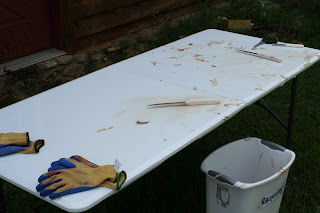**Warning: If you'd rather not think about how your chicken made its way to your enchilada, you may not want to scroll on down.**
Today, we processed 4 more birds (and the last of the roosters, thank heavens!). Though I did make a killing cut last time and assisted in the processing, this was the first time that I did a bird from start to finish on my own.
Caught him in the pen
Held him upside down by the feet for a minute while taking cleansing breaths (this is calming for me and him)
Put him head-first into the restraining cone
Held his head in one hand while slicing his throat with the other
Pierced his brain through his mouth, ending his consciousness and pain
Cut off his head and let him finish bleeding out and squawking (yes, squawking . . . headless squawking)
Carried his limp body to the table
Plucked his feathers where I make the first cut
Skinned and eviscerated him (much more detailed a process than it sounds like here)
Washed him clean
Plopped him into the pot of salted water
Carried him inside
Rinsed and patted him dry
Sealed him up in the storage bag
Placed him in the refrigerator.
Yep, I did it all!
Our table after we were finished (I forgot to show a pic of this set-up last time). I took a pic of what was in the trashcan and thought better of posting it. (You're welcome.)
My blood-stained gloves. Three things made today's slaughter difficult for me:
1. My bird bled A LOT. All over my gloves. Saturating them so that I could feel it on my skin beneath. And it was so warm. I don't know why that surprised me. Of course, it would be warm. But, for some reason, I just wasn't prepared for it, and it rattled me a bit.
2. The squawking. It's one thing when they squawk with their heads intact. It is another thing altogether for a headless bird, hanging upside down on the fence to be squawking in just the same way he was earlier that morning in the pen with all his buddies.
3. I'd swear these chickens knew what they were in for. They did not "go gently into that good night." In fact, two of them led us on a wild, um, chicken chase all over the yard after they siezed their small window of opportunity and slid out of the cage just before slaughter.
We use this water bucket to get the feathers off our gloves and/or hands during processing.
Blood-stained fencepost under the restraining cone
In the kitchen, ready for bagging.
For those of you who are thinking, "Okay, she's gone too far with these pics! They are just disturbing!", I would posit this --
These chickens were raised in excellent conditions, had an excellent quality of life, were processed in the most humane way we know of and in conditions much cleaner than the average factory.
I guess the goal of this post has been to bring you a bit closer to the process. I wanted to show a glimpse of the blood. You know, we prefer to trace our meal's origins back to the the shrink-wrapped styrofoam plate we select and place into our shopping cart. But that was not the food's beginning. It was an animal, that clucked and squawked and scratched at the ground. If we're going to eat meat, we need to acknowledge that that means we are eating animals -- the animals God created and entrusted to our care. And we ought to recognize and appreciate that those animals' blood was shed for our own nourishment.





so- what's a restraining cone for???
ReplyDeleteKim,
DeleteThe chicken goes upside-down, head-first into the cone. His head sticks out the bottom end so that you can cut his neck. The cone holds him still as he is cut and bleeds out. Are you sorry you asked? By the way, I recently added "Freshmen" to my iPod and think of you every time I hear it. :)